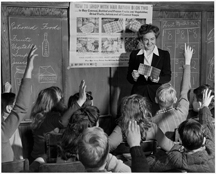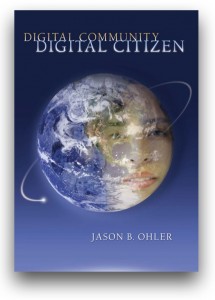Part I: The Big Picture
(wk 2)
This course is in three parts:
- Part I. The Big Picture – A history and overview of digital citizenship; how to approach digital citizenship from a policy perspective.
- Part II. Tools, Skills and Resources of Digital Citizenship – Theoretical and practical tools to help educators develop tools and approaches to address digital citizenship issues with students, schools, and districts
- Part III. Topics in Digital Citizenship – Of the many issues associated with digital citizenship, we have time to consider two: cyberbullying, media literacy
This week begins consideration of Part I.
– Narrative
– Video conference
– Goals, objectives
– Read/view/visit
– Discussion
– ePortfolio
![]()
Part I, Topic 1: History of Digital Citizenship
Watch this week’s screencast. It will orient you to this week’s materials in about 5 minutes.
Essential questions:
How have ISTE standards evolved from version 1, to version 2 (the Refresh Standards), to version 3 (the 2016 standards)? What might the next iteration (version 4) look like? (All versions are linked in the sidebar in the right hand side of the course site.)
Other questions to consider:
- What is the nature of the evolution of ISTE’s digital citizenship standards?
- How does understanding its evolution help us understand and plan for its future?
- How can it help us address the future issues that await us in this area?
Goals, objectives, understandings:
- To identify and explain how educational technology “version 2.0” evolved.
- To identify and explain how educational technology “version 3.0” evolved.
- To explain how ISTE standards changed in relation to technology use in education.
- To apply the ISTE refresh standards (Version 2) and the most recent standards (2016, 2017) to helping students understand the digital lifestyles they lead.
 Narrative
Narrative
This week we look at how digital citizenship emerged, and why it has become such an urgent topic in the K12 world. The following is adapted from your reading for this week, Part I of Digital Community, Digital Citizen:
The term citizenship has a long and illustrious history…Yet, we wonder whether our notion of citizenship accurately reflects our current needs. After all, a new perspective of citizenship has entered the public narrative that feels so different that we have given it its own name: digital citizenship. This term arises from the need to reconsider who we are in light of the globally connected infosphere in which we find ourselves. That is, given that citizenship seems to be directly related to behavior and social organization, and given that the Digital Age facilitates new kinds of both, we need to update our perspectives about citizenship to provide a more complete picture of who we are.
 This week we will look at how digital citizenship arose in K12 so that we can better understand the role it is likely to play in a future in which technology and connectivity continue to evolve rapidly and powerfully.
This week we will look at how digital citizenship arose in K12 so that we can better understand the role it is likely to play in a future in which technology and connectivity continue to evolve rapidly and powerfully.
In addition, this week we are interested in how ISTE, as well as the education world more generally, have addressed the problematic aspects of living a technological lifestyle. Most educational technology efforts are “pro technology” in nature, and seek to address how to use technology effectively. Fortunately, ISTE has always reserved some part of its standards to address the cautions in living a technological lifestyle. We are particularly interested in how the ISTE standards morphed from version 1 in the early 2000s (a broad consideration of the social impacts of technology) to version 2, the “refresh” standards, in the late 2000s (a more focused consideration of cyber behavior and living in a networked world). This is an excerpt from “What’s My Interest in Digital Citizenship,” which provides an overview of what you will read in the text:
From ISTE v1 to the refresh standards:
ISTE Standards v1, v2 and 3
Links to the original, refresh,
and 2016 ISTE standards appear
in the sidebar on the right.The original ISTE standards that appeared in the early 2000′s referred to our interest in the human side of technology as “Social, Ethical, Legal, and Human issues,” and defined it further by saying “Teachers (need to) understand the social, ethical, legal, and human issues surrounding the use of technology in PK-12 schools and apply those principles in practice.” Around the end of the decade, ISTE “refreshed” its standards, and this area of inquiry was renamed “digital citizenship.” The teacher standard in this area read: “Promote and Model Digital Citizenship and Responsibility.” It was further defined in the following manner: “(It is important that) Teachers understand local and global societal issues and responsibilities in an evolving digital culture and exhibit legal and ethical behavior in their professional practices.”
The 2016 version of the teacher standards continues on this trajectory, but with the following significant change: digital citizenship has become simply “citizenship.” As of 2016, it seems the needs of our citizens are no longer distinguished between RL and or online lives. Interestingly, the term “digital citizenship” is retained for the student standards.
The 2016 version of the teacher standards also cultivate more specificity. The first of four substandards reads: “Create experiences for learners to make positive, socially responsible contributions and exhibit empathetic behavior online that build relationships and community.” Note the mention of empathy. After a few decades of online interactivity, we have discovered that a lack of empathy – the ability to feel what someone else is feeling – is one of the Achilles heels of online communication.
S5d/T4d/A5d/C5c; informs all
The text continues:
Given the growth of networks between versions 1 and 2, the emphasis on living in a networked world is understandable. But I also think that placing so much emphasis on this misses some key components of the earlier version of the ISTE standards, particularly the notion that we need to come to grips with living side by side with incredibly powerful machines of our own creation. It is just as important that students understand how a microwave oven alters family eating patterns as it is that they understand how social media alters the nature of socializing. So, I have adopted both sets of standards, while focusing on the more current Digital Citizenship standard.
New words appear in the refresh standards, including digital, citizenship, culture, and global. (Two other new words figure prominently in the first standard: creativity and innovation, a topic I cover at some length in another book of mine, Digital Storytelling in the Classroom.) I was prepared for this. I conducted one of the earliest studies of an online educational community, and helped develop very early online courses and programs that used nothing other and slow email and conventional postal mail. I have been at it ever since. As a “cyber anthropologist” I was always observing networked behavior. Our interest in digital citizenship is a natural extension of living in a globally networked culture.
Given that ISTE’s digital citizenship standards
have evolved from version 1 to 3 in only 16 years
(from 2000 to 2008), and given the changes
between the versions are so significant, what
will version 4 look like?
It is our general interest in online anthropology, and cyber behavior, that will help us see more clearly who we are becoming as we set up communities in virtual space. From this, hopefully we will develop a clearer vision of who we would like to be. Digital citizenship can help us greatly in this regard.
A focus on digital citizenship in education will allow us to redefine the educational systems we build in RL (Real Life) and VR (Virtual Reality).
Video/audio conference activities: None scheduled.
Read/view/visit for this week:
- Part I of Digital Community, Digital Citizen. This focuses on the history and nature of the digital citizenship movement in K12 education. Feel free to read/scan the material. Part I is 71 pages in length. If you get strapped for time, here are the excerpts to focus on:
- - Preamble
- - Chapter One, The Road To Digital Citizenship
- - Chapter Two, Perspectives on Citizenship and Community, pages 40-48. For those using eBooks, this is the section labeled Three Levels of Community of ISTE Standards, which goes until the end of the chapter.
- - Chapter Three, Gathering Digitally, pages 60-64. For those using eBooks, this is the section labeled Guidelines for Virtual Behavior
You can obtain Digital Community, Digital Citizen in two ways:
An electronic version of the book is available to registered students for free through the UAS library. You need to sign into the UAS library site. If you prefer a paper-based copy, you can get one on Amazon. - Scan the most recent ISTE Digital Citizenship standards for teachers. You can find those here.
Keep this handy as I use it as the basis for identifying the standards we address each week in this course.
Find our discussion for this week at the Google+ Community. Look for my lead post for the week, which will always be a restatement of the week’s essential question. Please post at least one substantive posting about this week’s material, as well as at least three responses to colleagues’ postings. Please always address this question as well: How can you apply what you learned this week to your professional practice?
ePortfolio: By Sunday, post a 1-2 page synthesis of your major understanding from the week’s materials and discussion. Please use the following format:
- Thesis (main point)
- Development (discussion and support for your major point, referring to the week’s materials, as well as other sources and your own experience)
- Conclusion (wrap up of your discussion, and call for further study)
Add resources to your ePortfolio: As always, add resources you have discovered this week (or remembered from previous activities) to your ePortfolio. The goal is to build your ePortfolio into an online professional resource site you can use and build on in the future.
Citations, credits
Book cover, Digital Community, Digital Citizen. Ohler, J. Thousand Oaks, CA: Corwin Press.
Photo title: Landaff, Grafton County, New Hampshire. The Blue School teacher is a Massachusetts girl, 03/03/1941.
Source: NARA (National Archives and Records Administration)
Identifiers: ARC Identifier 521532 / Local Identifier 83-G-41273. Item from Record Group 83: Records of the Bureau of Agricultural Economics, 1876 – 1959
World, in header [Photoshop created image]. (2011). Created by Larry Addington for Corwin Press. It is a modified version of the cover of my book Digital Community, Digital Citizen. Thousand Oaks, CA: Corwin Press.
